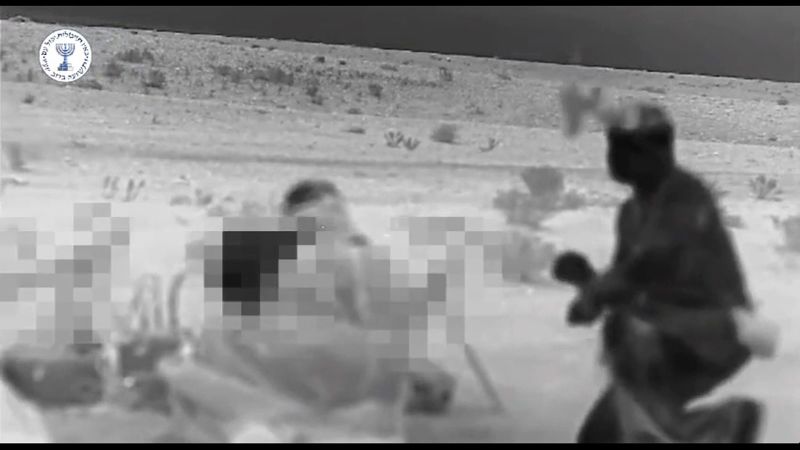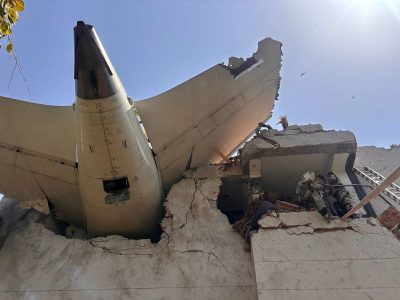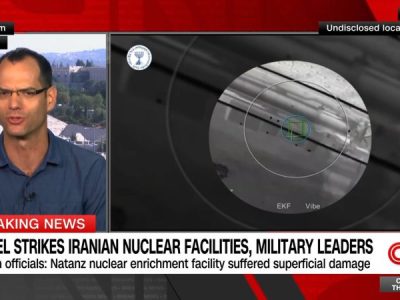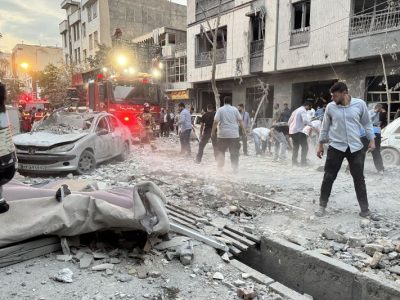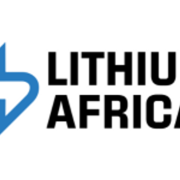
Israel launched a wave of unprecedented strikes on Iran shortly before sunrise Friday morning, hitting key sites in the nation’s nuclear program as well as residential areas in upscale neighborhoods of Tehran and killing some of the country’s highest-ranking military leaders.
Israel’s military said it used 200 fighter jets in the operation, called “Rising Lion.” Based on a review of strike targets, the attack had several prongs: Heavy strikes against at least one of Iran’s uranium enrichment sites as well as its stockpiles of ballistic missiles, and more targeted strikes in Tehran to decapitate the regime’s military leadership. It aimed to halt what Israel said was Tehran’s rapid progress in developing nuclear weapons.
The Israeli operation came after years of threats and days of heightened speculation.
Earlier in the week, the US had made efforts to withdraw non-essential personnel from locations around the Middle East, with one official citing “developing tension” in the region. On Thursday, US President Donald Trump told reporters in the White House that he did not want Israel to target Iran while talks to reach a new agreement to limit Iranian nuclear enrichment were ongoing.
In retaliation, Iran launched over 100 drones toward Israeli territory, Israel’s military said, and then a barrage of ballistic missiles.
Here’s what we know about how Israel’s attack unfolded, minute by minute. All times are local to Iran.
Pre-dawn: First strikes
Seven miles west of those buildings – still in the north of the city – another video showed damage from a strike on the upscale Chamran Town neighborhood. An entire wall had been stripped off one of the buildings, with people seen climbing through the rubble inside.
One strike hit centrally near Laleh Park, the site of protests over the 2022 death of Mahsa Amini, a 22-year-old woman who died after Iran’s morality police detained her for allegedly not wearing her headscarf properly.
Beyond the capital, a video showed a strike on the Piranshahr military base in western Iran, some 350 miles (about 560 kilometers) away from Tehran. The video showed the dark night sky being lit up by a series of rapid explosions, with smoke rising in the distance.
The Natanz nuclear facility includes two large underground halls believed to hold centrifuges for enriching uranium, according to a 2003 report from the Institute for Science and International Security, which includes satellite imagery of the site under construction in 2002. Based on that imagery, the latest attacks do not appear to have hit the underground buildings, but the full extent of the damage is not yet known.
Iran’s atomic energy agency said its primary nuclear enrichment facility “did not encounter serious damage” and there were “no radiation leaks that would cause concern to the people” after Israel attacked it. The spokesperson of the Atomic Energy Organization of Iran, Behrouz Kamalvandi, said on Iranian state media that the damage was on the ground level away from the underground facility at the plant.
Rafael Grossi, the head of the United Nations’ nuclear watchdog, the International Atomic Energy Agency, said in a statement that “radiation levels outside the Natanz facility remained unchanged” but added that there was “radioactive contamination present inside the facility,” which “can be managed with appropriate protective measures.”
4:14 a.m.: IDF speaks
Soon after the first explosions rocked Tehran, the Israel Defense Forces (IDF) announced it had launched preemptive strikes against Iran’s nuclear program.
It said it used jets to strike “dozens of military targets, including nuclear targets in different areas of Iran.”
The statement came at 3:44 a.m. in Israel, which is 30 minutes behind Iran’s time zone.
4:35 a.m.: Rubio distances US
Within minutes, US Secretary of State Marco Rubio stressed that the US was “not involved” in Israel’s strikes and that Israel’s actions were “unilateral.”
“Let me be clear: Iran should not target US interests or personnel,” Rubio said in a statement on X, anticipating a potential Iranian response.
Sunrise: Strikes continue
Just one mile west of the strikes on Chamran Town, daylight video showed the aftermath of a strike on Tehran’s Chizar neighborhood. A huge hole had been blown in the top two floors of a building, with twisted iron bars hanging from the concrete structure.
A 17-year-old Iranian, who asked to remain anonymous, said people were “screaming” in the streets. “I didn’t know what was happening. It was really scary,” the teenager said.
5:17 a.m.: Netanyahu announces Operation ‘Rising Lion’
As evidence of Israel’s strikes began to pour in, Netanyahu gave a televised address, saying that Israel had acted to “roll back the Iranian threat to Israel’s very survival.” He said the operation would continue for as long as it takes “to remove these threats.”
Netanyahu claimed Iran had produced enough highly enriched uranium for nine nuclear weapons. In a report sent to member states May 31, the IAEA also judged that Iran had enough uranium enriched to 60% purity, near weapons-grade, potentially to make nine nuclear weapons.
“Iran could produce a nuclear weapon in a very short time. It could be a year. It could be within a few months,” Netanyahu said. “This is a clear and present danger to Israel’s survival.”
The prime minister claimed Israel had struck Iran’s main enrichment facility in Natanz, which was corroborated by video of the site.
Past 6 a.m.
As the sun rose, the full scope of Israel’s attack became clearer. Videos published after 6 a.m. showed the aftermath of a strike on a military base and a cargo terminal in the western Kermanshah region, which borders Iraq, over 250 miles from Tehran and 167 miles from Baghdad.
6:26 a.m.: IAEA ‘concerned’
After Netanyahu claimed Israel had targeted the nuclear facility at Natanz, the UN nuclear watchdog confirmed that Natanz had been hit.
“The IAEA is closely monitoring the deeply concerning situation in Iran,” it said.
The agency said it was in contact with Iranian authorities regarding radiation levels in the area. In a later statement, it said it had not observed an increase in radiation.
8:35 a.m.: IDF announces killings
The Israeli military said it had killed three of the most senior men in Iran’s military and its nuclear program.
Maj. Gen. Hossein Salami, head of the secretive Islamic Revolutionary Guard Corps (IRGC), was the highest-profile of those killed. In its initial statement, Israel also said it killed Maj. Gen. Mohammad Bagheri, chief of staff of Iran’s armed forces, and Gen. Gholam Ali Rashid, leader of Iran’s emergency command.
Later, the IDF said it had killed Ali Shamkhani, a close aide to Iran’s Supreme Leader Ayatollah Ali Khamenei, and Amir Ali Hajizadeh, commander of the IRGC’s air force.
Many of the strikes on Tehran appear to have been targeting these senior officials. Last year, Israel demonstrated its ability to assassinate its adversaries in highly targeted attacks on Iranian soil. In July 2024, it killed Ismail Haniyeh, the political leader of Hamas – the Iran-backed militia in Gaza – by remotely detonating a bomb that had been hidden in his room in Tehran.
While Friday’s strikes appeared extremely targeted, there have been reports of civilian casualties.
8:48 a.m.: Iran responds
The IDF said that Iran had launched more than 100 drones towards Israeli territory, and that Israel’s air defenses were preparing to intercept them.
“We’re expecting difficult hours,” it said.
Following previous Israeli attacks against Iran and its proxies in the region, Tehran fired back with huge salvos of ballistic missiles.
The Institute for the Study of War, a think tank in Washington, DC, said it was “possible that Israel somehow disrupted Iran’s response by targeting Iran’s ballistic missile launch sites and stockpiles.”
Around midday
Early afternoon, Iranian media reported that Israel had launched a fresh strike on the northwestern city of Tabriz. Tamsin news agency said the Tabriz Airport had come under “heavy Israeli attack.”
12:26 p.m.: Trump posts
After learning the extent of Israel’s attack, Trump urged Iran’s leaders to agree to a new nuclear deal “before there is nothing left” of their country.
Trump said he had given Iran “chance after chance” to make a deal. “JUST DO IT, BEFORE IT IS TOO LATE,” he wrote on Truth Social, his social media platform.
Under a 2015 nuclear deal struck by President Barack Obama, Iran agreed to drastically limit its number of centrifuges and cap uranium enrichment at levels far below those required to make weapons, in exchange for sanctions relief.
But during his first term as president in 2018, Trump withdrew from the deal, saying the “rotten structure” of the agreement was not enough to prevent Iran from developing a nuclear bomb. He ramped up sanctions on Iran and threatened to sanction any country that helped the regime obtain nuclear weapons.
In his second term, Trump has revived efforts to strike a new nuclear deal with Iran.
Just hours before Israel’s attack, the president on Thursday cautioned Israel against launching a strike while talks are ongoing. US officials have held several rounds of high-stakes nuclear talks with Iran in recent weeks, demanding that Tehran stop all uranium enrichment activity.
Iran has long claimed that its nuclear program is peaceful. It has said it wants to keep enriching uranium for civilian purposes, like building a nuclear reactor, and not for weapons.
“Zero nuclear weapons = we DO have a deal. Zero enrichment = we do NOT have a deal,” Foreign Minister Abbas Araghchi said in an X post last month, setting out Tehran’s red lines in the talks.



